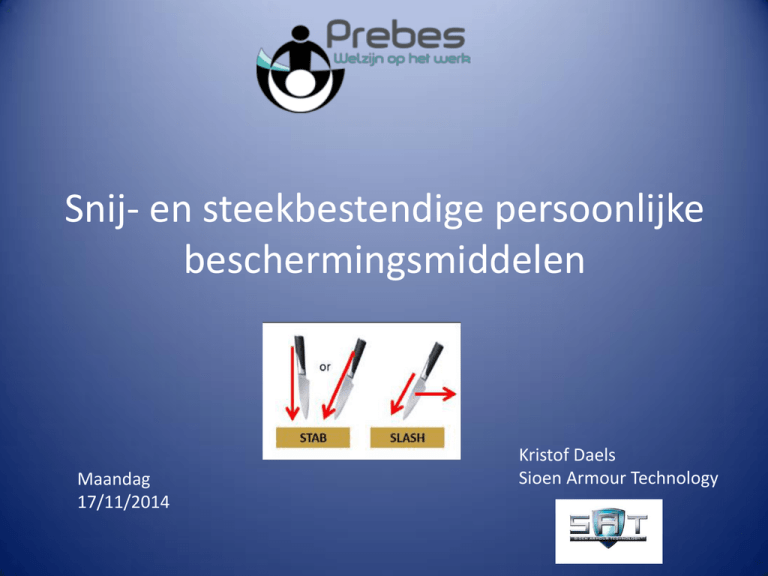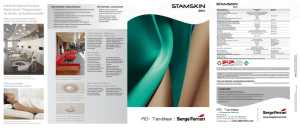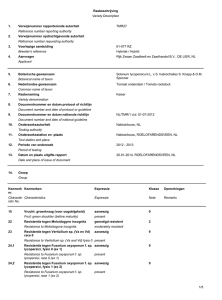Snij - Prebes
advertisement

Snij- en steekbestendige persoonlijke beschermingsmiddelen Maandag 17/11/2014 Kristof Daels Sioen Armour Technology Content • Keuze beschermingskledij : steekbescherming / snijbescherming • Problematieken actuele producten (benchmarking) • Project plan : nieuwe ontwikkeling SIOEN • Selectie van evaluatie-criteria & specificaties • Conclusies SIOEN & nieuw product TORSKIN • Praktische testing (simulatie realiteit) @ SAT • Toepassingsgebieden • Studies & didactisch materiaal ivm mesagressie Keuze van beschermingsmiddel (steekbescherming) Gebaseerd op risico-beoordeling van de omgeving, keuze : • Ofwel op basis van traditionele persoonlijke “ballistieke” beschermingsproducten => vesten met 360° bescherming van meest vitale organen (steekbescherming) • • Ofwel nieuwe aanpak : product met verhoging comfort & ergonomische voordelen tov traditionele producten Gekende problematieken kledij met steekbescherming • Comfort – Gewicht – Hitte-stress – bewegingsvrijheid • Prijs • Discretie – Vermijden van onnodige agressie • Overengineering ? – Beschermingsniveau in lijn met de realiteit ? – Welke toepassing : ‘agressie’markt / ‘industrie’markt – Traditionele kledij garandeert een volledige oppervlakte Keuze van beschermingsmiddel (snijbescherming) • Onderzoek door Sioen van huidige producten op de markt : – Comfort : • Irritatie (na diverse wasbeurten) • Ademend karakter van het T-shirt – Beschermingsniveau : • Volgens welke norm getest ? • Relatie : gewicht/m² v textiel in relatie met het beschermingsniveau Conclusie SIOEN : start nieuwe ontwikkeling PROJECT Combinatie van snij- & Steekwerendheid in 1 kledingstuk Project plan Anti-slash & anti-stab garment NORMS / Specifications Anti-slash Medical approach Comfort Anti-stab weight breathability Other parameters : discreteness + FLEXIBLE Skin-irritation No immediate death after knife attack Scope project SAT - Specificaties • Ontwikkeling van een gecombineerd snijwerend en steekwerend kledingstuk met volgende eigenschappen : – Licht gewicht (traditioneel : 2,5 kg target : 1,7 kg Large) – Comfortabel (niet irriterend) & ademend – Snijwerende bescherming ISO 13997 (minimum “level 4”) met combinatie van anti-slash bescherming volgens nieuwe CASTnorm ‘level 1’ op de hogere beschermingszones (vitale organen) – Steekwerende bescherming volgens HOSDB 2007-test methode : => energie level E2 : minimum 20 Joule (maxim 20mm penetratie mes) – Zoveel mogelijk naadloos werken – Moet op de huid kunnen gedragen worden Geselecteerde test-methodes snijbescherming Slash standards EN388 : 2003 EN ISO 13997 : 1999 HOS DB slash resistance standard for UK Police Protective gloves against mechanical risks Protective clothing 2006 Version / Publication N° 48/05 Mechanical properties Determination of resistance to cutting by sharp objects Classification level Level 1 Level 2 Level 3 Level 4 Level 5 index 1,2 2,5 5 10 20 Not determined (values in Newton) Pass / Fail Pass : no penetration with a force less than 60N AND average force (9 slashes) ≥ 80N Samples required 2 samples (60x100)mm Min 3 samples not less than (25x100)mm 3 samples (300x500)mm Cuts needed 10 15 9 Moving part Blade Blade Blade TESTS RESULTS Reference Studie @ SAT (sedert 2012) • Onderzoek van snijwerende bescherming van concurrentiestalen naar de norm ISO 13997 Doel van deze studie : -> ontwikkeling van een snijwerende basistextiel : - laaggewicht - Minimum “level 4” –ISO 13997 Supplier Neck protection 2 layers Ref 52-10-13 Development 2 layers M+P114004 NPK: -1,0 Slash resistance SR 97-5/D Higher density Development 2 layers M+P114004 NPK:-0,5 Slash resistance SR 97-5/D Weight (g/m²) Break force (N) Final Graph of Loads vs. Stroke Length EN ISO 13997 EN 388 HOSDB SLASH SIOEN 1930 44,4 N SIOEN 900 In test (results for next week) Report 1.13.11.20 60,5 N SIOEN 740 31,33 N Report 1.13.10.60 56,3 N A 966 26.0 N SIOEN 450 In test (results for next week) B B 1000 19.7 N Level 5 (>20N) C C 450 17.0 N Level 5 (>20N) Level 5 index 23,7 index 23,9 A Development 1 layer M+P114004 NPK: -1,0 Slash resistance SR 97-4/E Higher density Development 1 layer M+P114004 NPK: -0,5 Slash resistance SR 97-4/E SIOEN 370 15,43 N Neck protection 1 layer SIOEN 965 15,31 N D1 D 685 15,1 N D2 D 650 7,6 N E E 650 6,5 N Report 1.13.11.20 11,2 N Report 1.13.10.60 7,3 N Overzicht van andere specificaties Parameter ANTI-SLASH & ANT-CUT Comfort / Ergonomic Air-permeability ASTM D73704 645 l/m²/sec (100mm WC). Cyto-toxic-effect ISO 10993-5 No cause of Cyto-toxic effect Durability Shrinkage after 25x washing Norm / test method EN 5077(washing 40° ISO6330) & linedrying Single density Double density Comparable with AMC1 SioCOOL fabric Warp : 2,1% Weft : 4,3% Conform EN5077(<5%) Medische benadering door 2 chirurgen : Body mapping @ SAT Thesis : safety standards for stab-resistant body armour Anthony Bleetman Ligging van de diverse organen Zones waar Steekwerend+ snijwerend van belang zijn Finale conclusie – kledingstuk ~ body mapping Front Back Final conclusie – met kraag Front Back Medische verklaring van 2 chirurgen Praktische testing Toepassingsgebieden Agression with knives on the streets Toepassingsgebieden Surveillance people in public transport City guards on the street Night worker on streets Security on concerts / events Prison services Glass industry ‘Heavy work’ Time pressure industry Metal industry Kledingstukken Some conclusions coming from studies / thesis / reports / publications Need for knife protection • Study – HOSDB – Increase of knife carriers(especially pen knifes) • Eg : UK : – 2009 : According to a Youth Crime Survey in England & Wales, 23% of young people in mainstream education reported carrying a knife – 2011/2012 : 54% of young people in PRUs reported carrying a knife • European report on preventing violence and knife crime among young people : – Germany : young people between 14 and 21 years old are causing more assaults with knifes Rates for less severe and more severe assaults by age group in Germany, 1993–2009 The Management of Knife Injuries A CONSENSUS STATEMENT - May 2011 • Made by the association of surgeons of GB & Irelandsupported by the Metropolitan police & the surgical foundation – Knifes are used in approximately 6% of all violent crime in the UK; this equates to approximately 150,000 incidents per year. – Knife crime in particular is on the increase, especially in urban areas. – London : It is known that many young people today do not feel part of a close community. They feel alienated by society and seek refuge in gangs, alcohol and violence. Their opportunity for employment is reduced,and they are at the mercy of economic forces. .Human performance in slash attacks : • 87 male and female volunteers (between 2055 yrs) were asked to make one slash attack with an instrumented blade. No instructions on how to slash the target were given, each subject stood a metre in front of a target and the impact forces and direction of each attack was recorded Human performance in slash attacks Study : mechanism of injury • Military trainees were assessed in their knife slashing technique against a vertical humansized target. 67 male soldiers were given a large blade and were asked to slash a vertical target of adult proportions with the intention of attacking and causing injury. Assaliant technique in knife slash attacks – Anthony Bleetman (journal of clinical Forensic Medicine)

